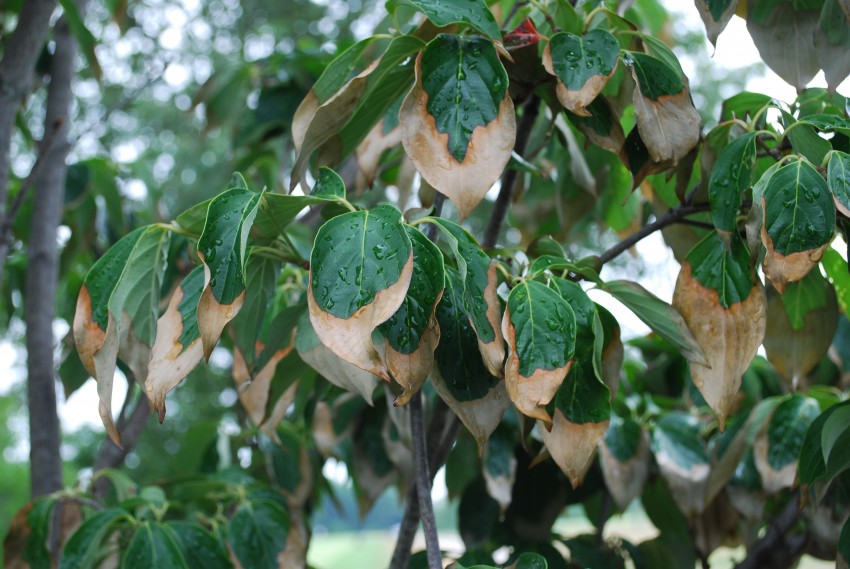Introduction
Leaf scorch is a physiological disorder of plants. It can affect most plants if the weather conditions are favorable. Extreme temperatures, heavy winds, periods of drought, and low soil moisture all contribute to leaf scorch. Scorching develops when water evaporates from a plant’s leaf surfaces, and is unable to be replenished through the root system. As a result, the leaf tissue becomes scorched, eventually turning necrotic. Plants that suffer from extreme leaf scorch may be defoliated, with many experiencing a decline in plant vigor.
Distribution & Habitat
Leaf scorch occurs globally, wherever susceptible plants are present.
Hosts
Leaf scorch impacts a multitude of plants. Plants that are prone to leaf scorch include alpine currant, ash, beech, birch, flowering dogwood, horse chestnut, Japanese maple, Norway maple, sugar maple, linden, and white pine. Evergreens are also commonly affected by leaf scorch. The most frequently affected are arbovitae, azalea, fir, laurel, Japanese andromeda, hemlock, pine, rhododendron, southern magnolia, spruce, and yew. Young trees, diseased trees, or trees that have been infested with insects are more susceptible to leaf scorch.
How Does Leaf Scorch Occur?
Leaf scorch occurs when adverse factors combine to weaken a plant. Periods of extreme heat, exposure to drying winds, and drought conditions are the primary causes of leaf scorch. Damage to a plant’s root system can also result in leaf scorch. Roots may be damaged in a variety of ways. They can incur mechanical and frost injuries; soil compaction may restrict their growth; they may be smothered by water during rainstorms; they may develop nutrient deficiencies; and they can erode when exposed to high concentrations of de-icing salt, fertilizer, or chemicals.
Disease pathogens and insects can infiltrate plants. Many are capable of disrupting a plant’s vascular system, which can contribute to the appearance of leaf scorch. Wilt diseases, such as pine wilt, oak wilt, and verticillium wilt create the conditions necessary for leaf scorch. The damage caused by leaf scorch may sometimes be indicative of a plant’s intolerance for a particular environment or exposure.
Symptoms of Leaf Scorch
Leaf scorch symptoms differ between plant species. On many deciduous plants, symptoms of leaf scorch generally appear between July and August. Leaves that have been scorched become discolored. Initially, a subtle yellowing between the leaf veins and along the leaf margins occurs, followed by a browning of the leaf tips. Eventually, the yellowing progresses, with tissue rapidly becoming necrotic at the leaf margins, and between the leaf veins. Some leaves may become entirely necrotic, without exhibiting any previous yellowing. Leaves that have been severely scorched may curl and wither. Scorched leaves are usually most abundant on the side of the plant exposed to direct sunlight, and prevailing winds. Leaf scorch may be confined to a single branch, or uniformly affect an entire plant.
Winter leaf scorch impacts many broad-leaved and narrow-leaved evergreens. Scorch injury on evergreens generally results from persistent exposure to heavy winds. On broad-leaved evergreens, such as azalea, euonymus, and holly, two long brown areas will form parallel to the main leaf vein, and enlarge as the plant becomes increasingly stressed. On narrow-leaved evergreens, such as arbovitae, fir, hemlock, pine, spruce, and yew, a browning develops at the needle tip, and progresses inward. As the plant declines, more needles will turn brown. Eventually, all of the needles may become necrotic.
Management
- While leaf scorch can defoliate plants, it seldom kills them altogether. To maintain plant vigor, and reduce the incidence of leaf scorch, use sound cultural practices. Ensure that plants are sufficiently watered, especially during periods of extended drought. A thorough drenching of the soil is most effective.
- Apply a layer of organic mulch around the base of plants in early spring. Proper mulching will help to improve the soil quality, conserve soil moisture, and moderate the soil temperature.
- Test the soil around scorched plants to determine if there are any nutrient imbalances.
- Apply fertilizers in early spring or late fall, following leaf drop, to minimize the potential of root injury. Avoid excessive fertilizer applications during summer, when the soil is dry. Do not use fertilizers that contain an abundance of nitrogen.
- Prune dead, diseased, and encroaching branches to promote air circulation throughout the crown, and reduce the amount of foliage the root system must support.
- If de-icing salts or fertilizer have been used around scorched plants, leach the soil with a slow trickle of water for twenty four hours.
- Protective screens can be erected around plants not suited to a particular climate or location. Screens can reduce a plant’s exposure to the wind.
Photo courtesy of Richard Buckley, Rutgers PDL
